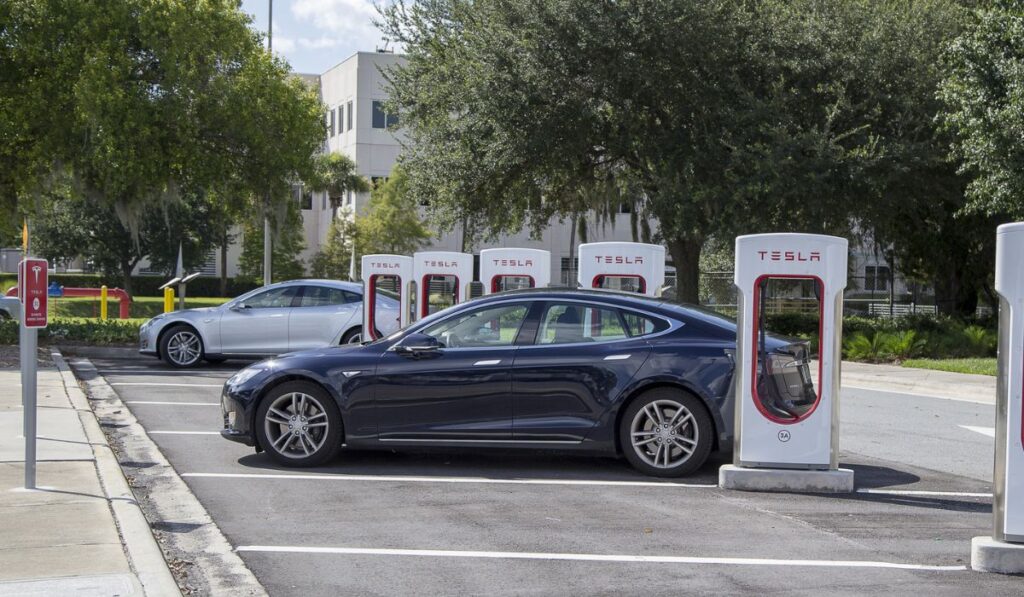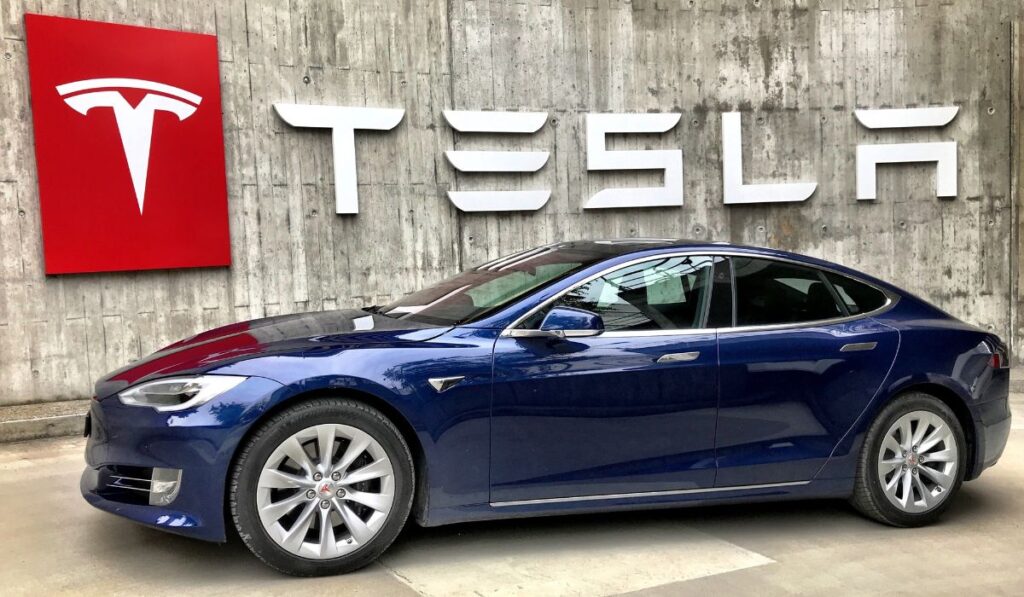Electric cars are convenient because they don’t typically use gas. But occasionally, some brands still need gas to for certain aspects of driving the vehicle. Do Tesla’s need any gas?
Teslas are fully electric vehicles that don’t require gas. You should never attempt to put gas in your Tesla as it could cause a fire or damage your car. Currently, the Tesla brand plans to only produce fully electric vehicles, but in the future, there may be a hybrid Tesla option.
Seeing as Tesla does not make gas or hybrid cars, you might be wondering how much it costs to charge them and whether electric power is more cost-saving than other types of fuel. Let’s look at all aspects of owning a Tesla and whether or not you will ever need to stop for gas when you own one.
Do Tesla Vehicles Use Gas?

No, Tesla vehicles do not use gas. Instead, they use electricity to power their motors. They are one hundred percent battery operated, meaning there is no space or means for liquid fuel inside the motor system.
Tesla seems to have no interest in producing gas-fueled vehicles, so do not expect to see them in the future. They pride themselves on cars that are operated by electricity to create a more sustainable future for the automotive industry.
What Do Teslas Use Instead of Gas?
Tesla engines are not powered by gasoline engines. Instead, they are powered by a motor which runs on electricity.
The difference between an engine and a motor is how they use an energy source for fuel. An engine uses gas, or another byproduct, and converts the product into energy. Whereas a motor transforms electricity into mechanical energy, which fuels the car to drive.
All Tesla vehicles rely upon large and sufficient lithium-ion rechargeable batteries. The electricity from the batteries does not only fuel the motors but other intricate systems within the car, from the windows to the entertainment system.
Electric motors are more efficient than gas-fueled engines, which is another reason why Tesla uses electricity instead of gas. The reliability and performance figures are much higher in electric-powered vehicles, meaning Tesla can pride itself on high-performing and efficient vehicles.
Telsa Battery Technology
The typical Tesla battery module is made up of lithium-ion battery cells, just like the ones we typically use. To generate enough power for the motor to drive the vehicle, all of the battery cells are woven together in a combination of parallel and series connections.
Glycol coolant is one concept that sets Tesla apart from its competitors, which utilizes a large number of small cells as opposed to a few big cells and improves cooling. The metallic inner cylinders that fit through the minuscule spaces between the battery cells are used to apply the coolant.
The temperature is evenly distributed throughout the cells, successfully reducing thermal hot spots, and guaranteeing a battery pack with a longer lifespan.
Can Teslas Use Gas as a Backup Fuel Source?
It is not possible to use it as a backup fuel source when your Tesla runs out of juice. Although it can be frustrating to be in the middle of a journey and run out of energy to power the rest of your journey, there are solutions.
First, it is smart to recharge your Tesla at home using a wall charger like this one (on Amazon) whenever you have a long journey ahead. Having a maximum charge will guarantee you can avoid needing to stop mid-journey. Or, you can find charging stations to recharge the motor so you can continue reaching your destination.
Alternatively, Tesla is working on ways to improve their recharging capabilities so drivers do not need to worry when they are running out of energy.
One option is to mount solar panels on the roof of the vehicle, which would recharge the battery as you travel. Establishing a small gas-powered generator that would turn on when the battery runs low is another possibility.
Finally, Tesla is constructing a network of charging sites that would enable travelers to pause and recharge their vehicles on lengthy drives.
Even though Teslas don’t have gas backups at the moment, it seems possible that this will change in the future. A German business is working to create novel and creative solutions to this issue as well as for hybrid cars. So, let’s hope there are more solutions to recharging a Tesla in the near future.
Does Tesla Make Hybrid Vehicles?

Tesla is a strictly electric-only automotive company and does not manufacture any hybrid or gas vehicles.
It does not seem the company has plans to create hybrid vehicles either. For now, Tesla is an electric-only business that supplies highly efficient electric vehicles.
How Are Tesla Vehicles Recharged?
Tesla vehicles can be recharged using power outlets. You can charge your Tesla at home or on the go. Here are the various recharging options:
Wall Connectors
It is possible to gain 44 miles of charge per hour using a wall connector. You can do this at home or at your office. You will need a specific wall connector to charge your Tesla at these rates. If you use a standard 120-V outlet, which is an option, you will only achieve 2 to 3 miles of charge per hour.
Wall connectors are also available across destination charging stations – including hotels, resorts, vineyards, and more. You can locate a destination charging station and use the wall connectors on the go to recharge your Tesla.
Superchargers
When you are out and about and need to charge your Tesla, you can find supercharging stations that are designed for Tesla drivers only. They are designed to recharge a vehicle with 200 miles in just 15 minutes.
Another impressive tool to make your future road journeys seamless is Tesla’s Go Anywhere tool. Before you even get in your vehicle, add your start and end places after choosing your vehicle’s configuration and the tool will find the fastest route. The Go Anywhere tool will even suggest charging intervals and Supercharger stops.
Advantages Of Driving A Tesla
Whether you want to drive a smart electric vehicle for aesthetic or sustainability reasons, a Tesla offers drivers many benefits.
- More sustainable. Tesla vehicles do not have any tailpipe emissions, making them Eco-conscious and good for the environment. They do not contribute to air pollution and are a great option for those looking to improve their carbon footprint.
- Great battery range. You will not need to worry about running out of charge mid-journey with a Tesla as all models offer impressive battery range. Most cars can offer between 244 and 326 miles from one charge.
- Money-saving. Although a Tesla vehicle might cost more to purchase, they are cheaper to run. They rarely require repairs or servicing and electricity is cheaper than gas. The average Tesla owner will save up to $1,000 on fueling costs.
- Charging capabilities. Tesla prides itself on efficiently charging vehicles. Owners will not need to wait around for hours and hours for their car to charge unless they use a 120-V outlet. Superchargers can provide 200 miles of range in 15 minutes.
With these impressive benefits in mind, there is no wonder many people are turning to electric cars, especially Tesla. They are a worthwhile investment for those looking for a sustainable ride that costs less to run and maintain.
How Much Does It Cost to Recharge a Tesla?
The fact that electric vehicles are less expensive to operate is one of their primary benefits. There is no better choice than an electric car for those seeking affordable alternatives as the price of oil rises every day.
Where and how you recharge your Tesla will dictate the cost. The model of Tesla you have will also change the price. A Model 3 is the cheapest to charge due to the smaller battery and the Model Y is the most expensive.
Superchargers and destination charging points will have their own set price, which will vary depending on where you are. Furthermore, the cost of charging your Tesla at home will depend on your energy supplier and how long you need to use the outlet to gain maximum charge.
The typical expense to charge a Tesla is around $15. The exact amount will vary depending on your vehicle model. In general, the cost of refueling a gas-powered vehicle is more than three times higher per mile than the cost of charging a Tesla.
What Happens If You Put Gas In A Tesla Vehicle?
Seeing as Tesla vehicles are not designed for gas use, there is not really a place to insert gas. However, if you do add gas to any part of your Tesla successfully, you will be asking for trouble.
An electric vehicle’s motor could be harmed and set on fire if gas is added to it. So make sure to leave the gas can at home if you’re considering switching to an electronic car. Adding gas to any part of your Tesla can risk your car catching on fire as your drive.
Just keep in mind that adding gas to your car will damage it and place you in danger. Therefore, it’s crucial to understand that gas is not an option when it comes to electric cars like Teslas.
Why Are Electric Cars A More Cost-Effective Option?

As well as electric cars, like Tesla vehicles, being cheaper to run, they are also cheaper to maintain. They are more environmentally conscious, making them more sustainable from their external materials to their motors.
Hence, Tesla and third-party shops pride themselves on offering cheaper repairs. Yet, it is quite rare for a Tesla to need a repair. Tesla cars do not need routine maintenance like oil changes, fuel filter replacement, spark plug replacement, or emission inspections.
The only repair you may need for your Tesla is a battery replacement. This can be done at a repair place which is trained to work on Teslas. Look for a Tesla repair center where the employees are trained to work on Teslas. When in doubt, call ahead to find out if a repair shop accepts Teslas.
